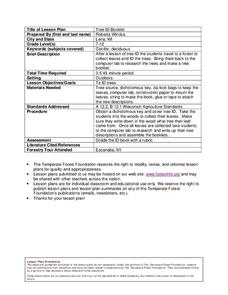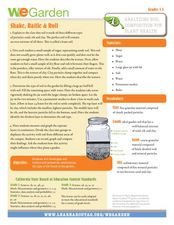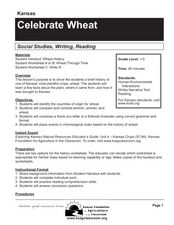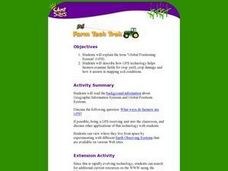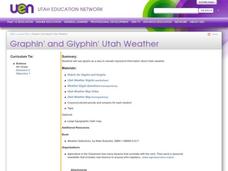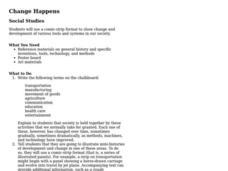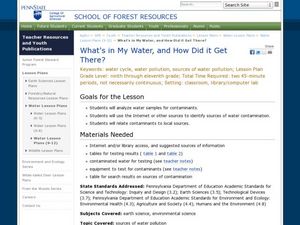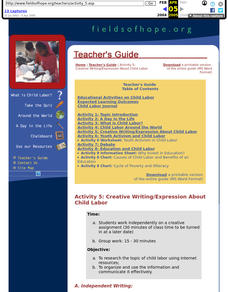Curated OER
Tree ID Booklet
Young scholars make a booklet of leaves they find and identify the tree they came from. In this tree identification lesson plan, students research the leaves on the internet to determine the tree they come from.
Curated OER
The Exceptional Nature of Cellulose
Students observe the affects of a substance's composition and structure have on its solubility. In this cellulose lesson students compare the amount of energy required to dissolve mono-saccharides with that required to dissolve...
Curated OER
Shake, Rattle & Roll
Students examine soil. In this science lesson, students examine the layers of soil. Students collect soil from various locations and separate the layers. Students record and chart their findings.
Curated OER
Conserving Resources by Watering Efficiently
Learners determine a watering schedule that promotes healthy grass growth. In this plants and natural resource conservation lesson, students plant grass seed in liter bottles and follow two different schedules that include "more...
Curated OER
Celebrate Wheat
Students compose a thank you letter and a time line about the history of wheat. For this wheat lesson plan, students learn and discuss the origin of wheat, and the differences between einkorn, emmer, and wheat.
Curated OER
Rock and Mineral Uses
Second graders investigate the various uses of rocks and minerals. They examine various rocks and minerals, identify the uses of rocks and minerals, and complete a worksheet.
Curated OER
FACS:Fibers
Learners investigate the difference between natural and synthetic fibers. They correctly match natural and synthetic fibers.
Curated OER
Graphin' and Glyphin' Utah Weather
Fourth graders use glyphs as a way to visually represent information about Utah weather. These nonverbal representations help students collect and interpret data in a visual format.
Curated OER
Change Happens
Students research different inventions that have changed over time. They use a comic strip format to illustrate how an area has changed. They share their comic strips with the rest of the class.
Curated OER
Watershed Investigations
Students explore the components of a watershed and the factors that affect it. They read a topographical map and use geometry to determine the area of a watershed. Students estimate the volume of a body of water and perform runoff...
Curated OER
Light Plants and Dark Plants, Wet Plants and Dry Ones
Learners plant sunflower seeds in plastic cups, and once germinated, these are exposed to different conditions of light levels and/or soil moisture contents. Students measure growth of the seedlings every few days using non-standard...
Curated OER
What Trickles Down?
Learners explore different levels of permeability and compare the permeabilities of several different materials. They are introduced to the basic concepts of building design, landscape architecture, and environmental pollutant transport....
Curated OER
Identifying Various Roles of Women
Eighth graders view pictures of various women from Santa Clara County history. They discuss the occupational roles of the women and try to identify occupational roles they are familiar with. They answer questions on a Bio Brief...
Curated OER
Know Your Watershed
Learners investigate the importance and the location of their own watershed by visiting and EPA website and also work in groups to create an action plan on how to protect their local watershed.
Curated OER
Taking a Stand: Pros and Cons of Forest Fires
Students explore the pros and cons of forest fires. In this science lesson, students research the ecological implications of forest fires. Students record their findings in journals and compose a persuasive e-mail to government officials.
Curated OER
Grab Quick and Easy Snacks
In this healthy eating worksheet, students complete a maze. Students avoid the pictures of the "dead end" snacks high in sugar, fat and calories. There is a tuna pita sandwich recipe on the page.
Curated OER
A Land of Milk and Honey
Ninth graders examine the term multiculturalism. In this Cross Curricular History and Social Studies lesson, 9th graders analyze a video clip. Students investigate the requirements for becoming a citizen in Australia.
Curated OER
What's in My Water, and How Did it Get There?
Students analyze water samples to see the contaminants and then use the Internet to find the sources of the contamination. In this investigative water lesson students analyze water and work together to solve the mystery of...
Curated OER
Cambodian New Year
Learners compare and contrast the New Year celebration in Cambodia to the celebration in the United States. They mathematically determine the amount of beans added to the "mountain" during the three day celebration.
Curated OER
Placing Deerfield in a National Context
Eleventh graders understand that world events brought important changes that impacted Deerfield. Students use information gained from this and other periods to develop a continuum showing the growth of the Deerfield community.
Curated OER
Activity 5: Creative Writing/Expression About Child Labor
Middle schoolers research child labor using Internet resources. They present the information in a creative writing piece and post it on Chalkboard.
Curated OER
What if the Mormons had not come to Utah?
Fourth graders use critical thinking, evaluation, and geography skills to find alternative locations that Brigham Young could have taken the Mormons to settle.
Curated OER
When Rice Was King
Students examine the origins of rice production in the South. They identify the steps involved in rice cultivation, examine photos of plantation life, conduct interviews, and research the economic base of their own community.
